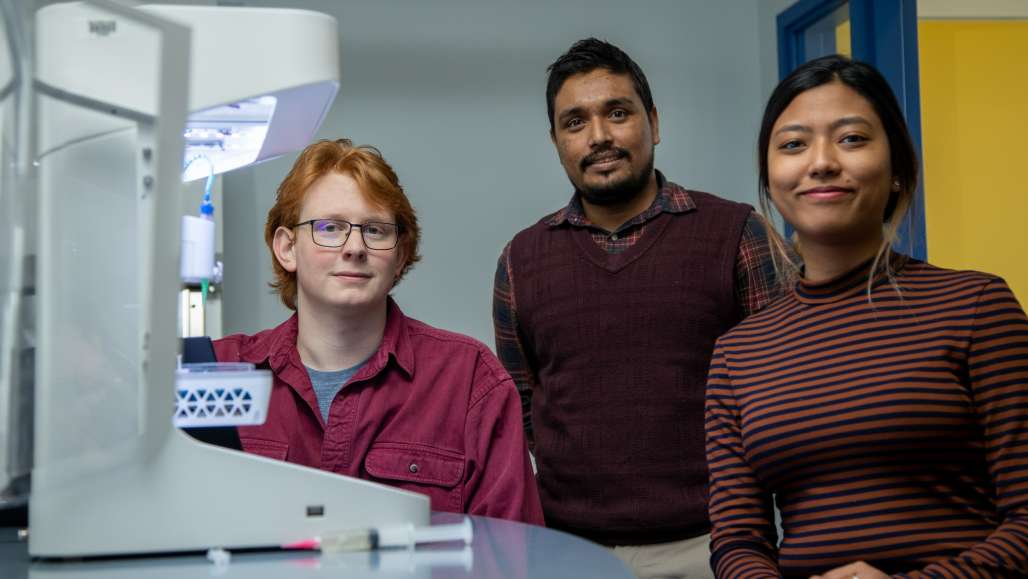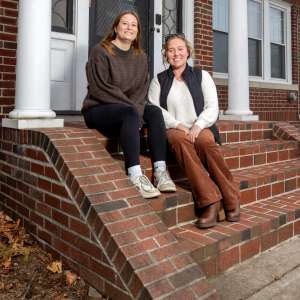Cutting-edge biomaterials research part of undergraduate experience at KSC

Slesha Tuladhar did not set out to change the world. Her interest was much more benign.
The Keene State junior was, she says, simply curious when she chose to become part of a small federally funded student research team at the college focused on testing biomaterials for bioprinting, with the goal of developing human tissues and organs using a 3D printer.
A dual major – architecture, honors program; and sustainable product design and innovation – her plate was already full, her academic pursuits in clear focus.
“When I first started, I had no idea what this even was or what it involved,” Slesha, a native of Kathmandu, Nepal, confesses. “I started by having to read two papers, and they made no sense to me. But this quickly became so much more than studying research papers.

“Our work has been a practical implementation to the theories that I first learned in high school,” the full-scholarship student adds. “I have learned so much. Moreover, it has made me confident enough to present findings in front of a scientific audience.”
New Hampshire is at the front of tissue-growth research, and in a couple of bright, well-purposed labs at Keene State, a liberal arts institution nestled in the southwest corner of the state, the quest to do innovative biomaterials research continues. The potential applications for regenerative medicine, other healthcare needs, and manufacturing are not insignificant, and just a hint of what might be possible, Tuladhar says.
Professor MD Ahasan Habib, a native of Bangladesh who earned his Ph.D. from the Department of Industrial and Manufacturing Engineering at North Dakota State University, is guiding the NH BioMade-funded effort.
NH BioMade is short for New Hampshire Center for Multiscale Modeling and Manufacturing of Biomaterials. It is an EPSCoR project funded by the National Science Foundation that aims to accelerate the state’s biomaterials industry through research, academic-industrial partnerships, and workforce development.
Dr. Habib and his students are members of the project tissue engineering research thrust, for which the professor received a NH BioMade seed grant. Funding for Dr. Habib’s student researchers is made possible by NH BioMade and NH INBRE, which is underwritten by the National Institutes of Health.
NH INBRE is short for IDeA Network of Biomedical Research Excellence. EPSCoR is short for Established Program to Stimulate Competitive Research, which is a program at several federal agencies.
Faculty and graduate students at UNH and Dartmouth are collaborating with Dr. Habib and his team of students.
Undergraduate research opportunities of this ilk are the exception to the rule, Jim Kraly, Associate Dean of Sciences, Sustainability, and Health at Keene State, pointed out.
“The opportunities are also transformative,” Kraly added. “They are collaborative, they are interdisciplinary, and they typically lead to the development of key professional skills.”
Carter Nelson would agree. Nelson got involved as part of an internship with NH BioMade three years ago, then switched to undergraduate research, which is a paid opportunity, he said.
Putting research into words
Carter, a senior from Exeter, NH, and Slesha were Dr. Habib’s first student research assistants. Recently, a peer-reviewed journal article that they were lead authors on, was published. Lead authorship rarely goes to undergraduates, says Brad Kinsey, UNH mechanical engineering professor and principal investigator for NH BioMade.
Carter presented his research at the NH BioMade spring conference last year, and impressed faculty and graduate students alike, Kraly said. Tuladhar delivered an oral presentation at Keene State’s Academic Excellence Conference, also in the spring.
“They took the lead from the start,” Dr. Habib said of Carter and Slesha. “I’ve come to be able to really rely on them, and that is important.”
Slesha and Carter are quick to flip the script, singling out their professor’s natural ability to lead and counsel without getting in the way. Dr. Habib’s technical and scientific guidance, his patience, and his disarming way of making students think and solve challenges on their own have made for a positive and fulfilling educational experience, the students agreed.
Connor Quigley, a sophomore from Durham, NH, joined the research team after taking a class with Dr. Habib, who was advertising paid summer internship roles for researchers in training.
Amar Abbatiello, a senior from Ashfield, MA, is also part of the team. He designed and is prototyping a perfusion-based bioreactor to supply fresh food to encapsulated cells. He presented a research paper on his work at Dartmouth and will do the same at a pair of upcoming conferences, Dr. Habib noted, the Institute of Industrial and Systems Engineers Conference, and the Manufacturing Science and Research Conference organized by the American Society of Mechanical Engineers.
Amar will graduate with a BS in Sustainable Product Design & Innovation in General Engineering.
Another student researcher, Mark Torselli, graduated last year.
“It seemed interesting,” Connor says, “with opportunities to learn some advanced topics. I figured I would apply, and I got it alongside another student, from UNH Manchester, Anh Nguyen.”
Connor’s role ran through this academic year, and he will continue his research through this summer, he said.
He called Dr. Habib’s knowledge and flexibility “difference-making and motivating.”
“He gets that, working in the lab along with taking classes, can be hectic for scheduling and he is always understanding of conflicts. I also feel supported in the research space through our collaboration and communication. Whether it is materials we may need, or sharing figures, or even a simple question, our communication is open and frequent.”
Added Slesha: “We are provided the resources, equipment, and necessary theoretical background about the research, which makes doing experiments easy. … The (research) team is motivated, curious, and there for each other.”
Dr. Habib said he most admires the “enthusiasm and the passion” that his student researchers have brought to the process. More technically, he added, research of this kind requires demonstrated competencies in math, CAD, hands-on experience and writing skills,” not the likeliest of combinations necessarily. “Each research student brings these valuable sets of expertise to my lab, and the continued research in my lab is also improving their expertise.”
Small steps … big possibilities
A project of this kind is only as good as the different parts that make up its sum, and a strong sense of teamwork, Kinsey says.
“The NH BioMade project has benefited tremendously from our collaborations with Profs. Habib and (Lisa) Hix at Keene State, in particular the tremendous research conducted by their students.”
Keene State offers the only program in New England that combines industrial design, project management and manufacturing engineering technologies.
“Wherever the world is moving, we are trying to go with them,” Dr. Habib said when talking about building a skilled manufacturing workforce for a recent story in Keene State Today, the college’s alumni magazine. “That forward-looking focus means the (sustainable product design and innovation) program adds classes like bio fabrication to prepare students for their evolving careers.”
Kraly, who along with Hix, a professor of Sustainable Product Design and Architecture, is a NH BioMade team member. He, like Kinsey, is excited by the progress that has been made and the collaborative, open-minded spirit driving the research.
“Professor Habib has moved some equipment and instrumentation into core facilities in the biology department to work with live cells,” Kraly said. “We are all amazed with the progress that he and the team’s research have been able to show since his arrival.
“I’m not tooting our own horn, but this taps into the broad opportunity of learning that a student can get here. That you can be a part of this kind of project, and get this level of mentorship, even in your first year, is exciting to think about.”
Breaking it down in its most-simple terms, Connor described the research this way: “What we are working on is a small part of a multi-disciplinary initiative. That small part has to do with testing certain materials’ properties before and after they are printed.”
Carter acknowledged that his emphasis remains on material testing to discover a mixture that is easily printable, has positive effects on living cells and that can structurally support itself in larger scaffolds – or organs. Testing cell cultures is Slesha’s area of research focus.
“As far as anything being implementable from a medical standpoint, we’re far away still,” Carter said. “I’m still printing without live cells. I know there are other people much closer than we are. But we are contributing to this process. It’s a big deal because if this can be accomplished then patients can quickly get replacement organs and tissues made from their own cells for surgery, injury repair and many other medical uses.”
The students are aware that their role in this research has a shelf life, but they are soaking up new skills, and appreciating the hope and possibility that drives this kind of work.
In time, Slesha said, she will move away from the research to focus full-time on her professional ambition to be an architect. However, she cannot help but think that her research experience will add to her overall confidence and broaden her appeal as an employee prospect. The core principles, she notes, cross disciplines.
“I think it is so cool that, as an architect, I can bring something into life that does not exist using my skills and my imagination,” Slesha said. “My dream is to travel with my work. I want to leave a little piece of myself all around the world with the things that I design.”
Support for the NH BioMade Project is provided by National Science Foundation EPSCoR Research Infrastructure Improvement Award #1757371. Research supported by New Hampshire-INBRE through an institutional Development Award (IDeA), P20GM103506, from the National Institute of General Medical Sciences of the National Institutes of Health.





